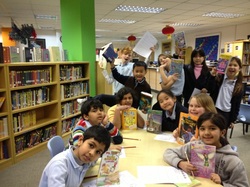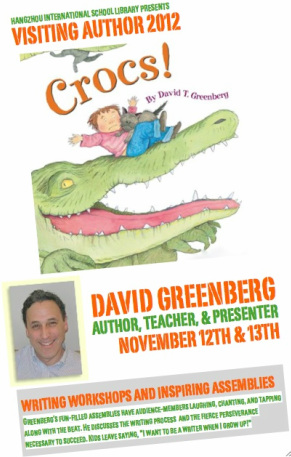HIS LIbrary Year in Review: a Video

2011-2012 Summary
Evidence and Artifacts: ALA/AASL Standards
Standard 1: Teaching for Learning
Candidates are effective teachers who demonstrate knowledge of learners and learning and who model and promote collaborative planning, instruction in multiple literacies, and inquiry-based learning, enabling members of the learning community to become effective users and creators of ideas and information. Candidates design and implement instruction that engages students' interests and develops their ability to inquire, think critically, gain and share knowledge.
Elements
1.1 Knowledge of learners and learning
1.2 Effective and knowledgeable teacher
1.3 Instructional partner
1.4 Integration of twenty-first century skills and learning standards
Standard 1: Teaching for Learning
Candidates are effective teachers who demonstrate knowledge of learners and learning and who model and promote collaborative planning, instruction in multiple literacies, and inquiry-based learning, enabling members of the learning community to become effective users and creators of ideas and information. Candidates design and implement instruction that engages students' interests and develops their ability to inquire, think critically, gain and share knowledge.
Elements
1.1 Knowledge of learners and learning
1.2 Effective and knowledgeable teacher
1.3 Instructional partner
1.4 Integration of twenty-first century skills and learning standards
| instructional_collaboration__integration_opportunities.pdf | |
| File Size: | 67 kb |
| File Type: | |
A collaborative instructional lesson plan using an inquiry-based learning model in collaboration with a classroom teacher. With knowledge of the school curriculum, I offer support with online database use, technology, web resources, and any pre-designed lesson plans that might apply.
| three_faculty_workshops-_social_media_information_technology.pdf | |
| File Size: | 90 kb |
| File Type: | |
An overview of three sample faculty workshops for the first semester of the school year. They cover technology integration in the classroom and instructional lessons on the use of blogs, wikis, and social bookmarks.
| using_noodletools_for_mla_citation.pdf | |
| File Size: | 1841 kb |
| File Type: | |
A 43-slide Powerpoint presentation designed as an instructional, stand-alone learning module for teachers or students wishing to learn the basics of a the citation tool Noodletools.
| works_cited_page_creation.ppt | |
| File Size: | 427 kb |
| File Type: | ppt |
A short Powerpoint presentation designed as an anticipatory set for introducing the basic structure of an MLA Works Cited page. Contains a pretest, and provides answers.
| teacher_slms_planning_document.pdf | |
| File Size: | 74 kb |
| File Type: | |
A teacher/school library media specialist planning document form that I use when collaborating with classroom teachers. It helps guide us in sharing our goals, assessments, and instructional time.
Standard 2: Literacy and Reading
Candidates promote reading for learning, personal growth, and enjoyment. Candidates are aware of major trends in children's and young adult literature and select reading materials in multiple formats to support reading for information, reading for pleasure, and reading for lifelong learning. Candidates use a variety of strategies to reinforce classroom reading instruction to address the diverse needs and interests of all readers.
Elements
2.1 Literature
2.2 Reading promotion
2.3 Respect for diversity
2.4 Literacy strategies
Promotion poster for visiting author David Greenberg; used on school website, library blog, and in school magazine Shanghai Community International School's magazine Communitas.
| curricular_connections_poetry_collections_and_anthologies.pdf | |
| File Size: | 99 kb |
| File Type: | |
A document offering various and specific connections between poetry and curricular content such as Physical Education /Team sports, Earth Week, Nutrition and Health, Social Studies, and Music.
| evaluating_childrens_literature.pdf | |
| File Size: | 94 kb |
| File Type: | |
Eight book reviews I have written on children’s picture books. Includes book summaries, discussion of the quality of illustrations, and a historical perspective of period/time in which they were printed.
| _characteristics_of_young_adult_literature.pdf | |
| File Size: | 100 kb |
| File Type: | |
A review of the characteristics of young adult literature. Includes a discussion of the differences between juvenile literature and young adult literature and a comparison between Philip Pullman’s “The Golden Compass” and Sylvia Plath’s “The Bell Jar”.
| fiction_study__selection_tools.pdf | |
| File Size: | 171 kb |
| File Type: | |
Fiction Study and Selection Tools: Using five well-known selection tools , I summarize and cite selection sources and describe the process by which I used the search tools.
| review_of_nonfiction_award_winner.pdf | |
| File Size: | 313 kb |
| File Type: | |
A detailed review of a non-fiction , award-winning book. I discuss the historical accuracy of Ruby Bridges “Through My Eyes” and the author's use of photos, illustrations, captions, headings, and structure.
Standard 3: Information and Knowledge
Candidates model and promote ethical, equitable access to and use of physical, digital, and virtual collections of resources. Candidates demonstrate knowledge of a variety of information sources and services that support the needs of the diverse learning community. Candidates demonstrate the use of a variety of research strategies to generate knowledge to improve practice.
Elements
3.1 Efficient and ethical information-seeking behavior
3.2 Access to information
3.3 Information technology
3.4 Research and knowledge creation
| information_access__sharing_in_web_2.0_applications.pdf | |
| File Size: | 55 kb |
| File Type: | |
"Information Access Sharing in Web 2.0 Applications"- A journal review on digital awareness that discusses the political and social implications that arise when librarians and archivists make decisions about how they share information in the electronic world.
| webpage_evaluation.pdf | |
| File Size: | 631 kb |
| File Type: | |
An example of one of the many webpage reviews I've created over the years. In this review, I address elements such as aesthetic appeal, design, site navigation, and links. Includes screen shots.
| selection_project.pdf | |
| File Size: | 153 kb |
| File Type: | |
Collections Selection Plan: Includes rationale, description of needs, library information, process for locating sources, and tools used (Mackin, Follett, Children’s Core Collection, etc...). Includes annotated list of fifteen titles including audiovisual, magazine, fiction, web site, ELL text, and non-fiction texts. Includes reviews, reading levels, Dewey call numbers, and item costs.
| poetry_annotated_webography.pdf | |
| File Size: | 102 kb |
| File Type: | |
Poetry Webography: an annotated list of specialized gateways and resources for teachers of poetry and English. Includes an overview of “the invisible web”, helpful links not found in internet search queries, and an overview of why quality gateways are invaluable resources for educators and students.
Standard 4: Advocacy and Leadership
Candidates advocate for dynamic school library programs and positive learning environments that focus on student learning and achievement by collaborating and connecting with teachers, administrators, librarians, and the community. Candidates are committed to continuous learning and professional growth and lead professional development activities for other educators. Candidates provide leadership by articulating ways in which school libraries contribute to student achievement.
Elements
4.1. Networking with the library community
4.2 Professional development
4.3 Leadership
4.4 Advocacy
Candidates identify stakeholders within and outside the school community who impact the school library program. Candidates develop a plan to advocate for school library and information programs, resources, and services.
Candidates advocate for dynamic school library programs and positive learning environments that focus on student learning and achievement by collaborating and connecting with teachers, administrators, librarians, and the community. Candidates are committed to continuous learning and professional growth and lead professional development activities for other educators. Candidates provide leadership by articulating ways in which school libraries contribute to student achievement.
Elements
4.1. Networking with the library community
4.2 Professional development
4.3 Leadership
4.4 Advocacy
Candidates identify stakeholders within and outside the school community who impact the school library program. Candidates develop a plan to advocate for school library and information programs, resources, and services.
| professional_journal_review.pdf | |
| File Size: | 56 kb |
| File Type: | |
Reviews of two professional journals: Educational Leadership and Technology and Learning.
| research_project_survey.pdf | |
| File Size: | 40 kb |
| File Type: | |
Survey questions used to collect data on our school online subscription database use. The data gathered from this survey helped drive changes in the School Library Program curriculum and instigated the creation of online tutorials for students and faculty.
| influential_research_school_library_advocacy.pdf | |
| File Size: | 92 kb |
| File Type: | |
Identifies and summarizes influential research studies that apply to school libraries. Includes research studies that connect library expenditures to student achievement and addresses how the school library curriculum helps students meet achievement standards. Research studies on how libraries influence school performance through faculty development and access to online databases are also discussed.
| electronic_database_curricular_needs_of_the_school.pdf | |
| File Size: | 114 kb |
| File Type: | |
Action Research Plan and survey for evaluating the research and electronic database needs of the school. Created, modified, and used at my current school.
| jazzing_up_wordpress_website.pptx | |
| File Size: | 1699 kb |
| File Type: | pptx |
A presentation used as part of a professional development workshop I designed at my current school to help teachers make their class websites look more creative and user-friendly. Users will find instructions for how to insert images and links, change the size and color of font, password-protect a page, and upload a pdf document or newsletter onto a class webpage.
Standard 5: Program Management and Administration
Candidates plan, develop, implement, and evaluate school library programs, resources, and services in support of the mission of the library program within the school according to the ethics and principles of library science, education, management, and administration.
Elements
5.1 Collections
5.2 Professional Ethics
5.3 Personnel, Funding, and Facilities
5.4 Strategic Planning and Assessment
| administering_the_school_library_curriculum-related_program.pdf | |
| File Size: | 77 kb |
| File Type: | |
Administrating the school library curriculum-related program: discusses flexible scheduling, information literacy, and school librarian/teacher collaboration.
| web_2.0_opportunities_and_uses.pdf | |
| File Size: | 97 kb |
| File Type: | |
Web 2.0 technologies are changing how we communicate, share, and design on the world wide web. Media specialists must educate the learning community in Web 2.0 use.
| technology_plan.pdf | |
| File Size: | 88 kb |
| File Type: | |
Technology plan for the creation of a multimedia mini-lab within the school library allowing students and faculty to create multimedia projects that support curricular goals and extra-curricular projects. Includes plan, justification, hardware, software, timeline, budget, training, and evaluation.

